South Africa’s first post-World War II race
Author
- Marius Matthee
Date
- July 31, 2007
Related articles
- The 1960-1975 South African Drivers Championships - Grand Prix at the Cape, by Mattijs Diepraam/Felix Muelas/Rob Young
Who?Basil Beall What?ERA R3A Where?Durban When?2nd Fairfield Handicap (January 24, 1948) |
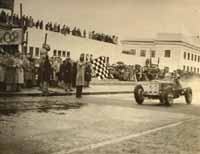 |
Why?
Durban, that vibrant holiday city on the KwaZulu-Natal coast, was a hive of activity during late January 2006. Summer is usually a hectic time of year but by mid-January life always settles down to a more sedate pace for the locals when holiday goers pack up and leave for home. This time it was different and the festivities seemed to have no end - and for a pretty good reason, one must add.
The city was given the honour of staging the first-ever A1 Grand Prix of this newly established motorsport championship series. A Monaco-style street race was the dream of the organizers and the green light was given for a circuit on the Snell Parade and streets in the vicinity of the city’s beautiful beachfront.
The locals left no stone unturned in their efforts to promote their Grand Prix. Tourism officers, businessmen, celebrities and the ever-present politicians were jockeying for prime-time television to deliver their repertoires in the days building up to the race. All fair and well, except for the fact that these people know very little of their city’s motor racing heritage. Everyone, to the number almost, was emphasizing that this was the “first ever motor race” to be staged in the city. Wrong, ladies and gentlemen!
For the sake of these folk, let us turn back the clock in history and return to the very same Snell Parade for another very historic South African race at the exact spot where the A1 Grand Prix boys started their race. The year is 1948…
It was more than two years after the completion of the Second World War that the first motor car road race meeting was eventually held in South Africa. Life first had to get back to normal, motor clubs had to re-organize themselves and new circuits had to be found, since many pre-war venues were not available anymore due to various reasons. Motoring competitions during the immediate post-war period were characterized by events like hill climbs, speed trails and gymkhanas. Even though racing was off to a slow start, the enthusiasm amongst motoring enthusiasts never dwindled during the chaotic war years and it was the Natal Motorcycle and Car Club that eventually took the initiative to persuade the authorities to allow them to hold a proper race on Durban’s beachfront.
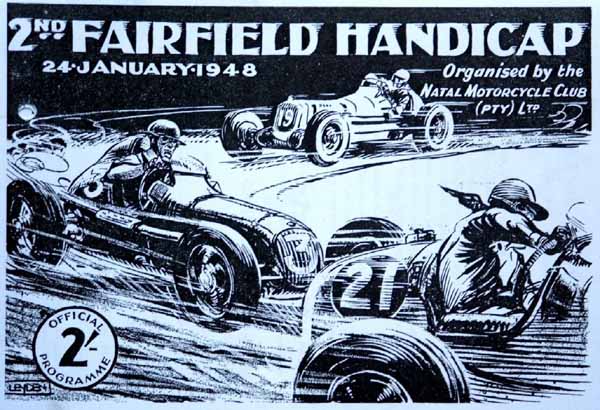
The green light was given to stage the 2nd Fairfield Handicap on 24 January 1948 on the Snell Parade, where a race was also held before WW2. This race, on 28 January 1939, was called the Fairfield Handicap and it was thus decided to again use this name in honour of the great pre-war driver, Pat Fairfield, who was killed at the Le Mans 24 Hour race in 1937. City officials made it clear, though, that the future of motor racing in Durban would depend on crowd behavior and them co-operating with the police.
With this in mind, the NMCC appointed a large corps of 200 volunteer marshals, who together with constables of the city’s Traffic Department were to receive direct police authority from the Chief Constable of Durban. More than 20,000 people were expected to attend and jam the Snell Parade and vantage points along Walter Gilbert Road. Appeals were made to the public to stay off the course and to leave children and dogs at home.
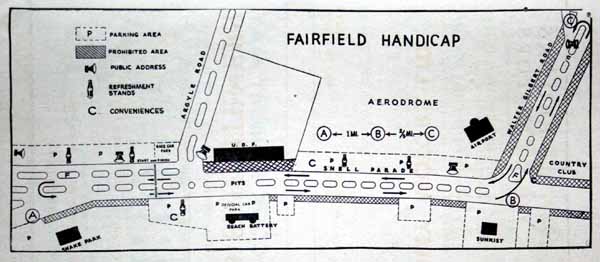
A map of the 1948 circuit.
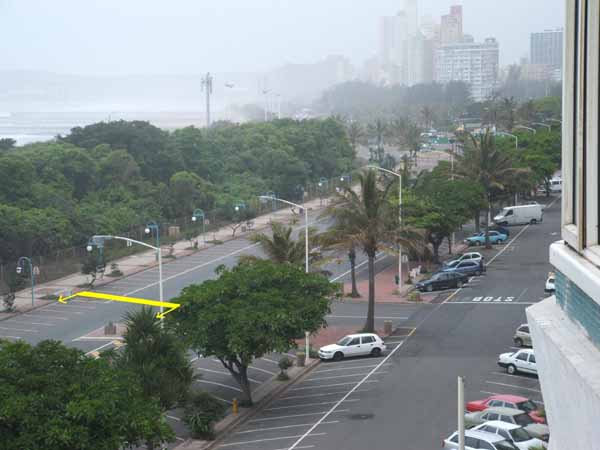
Durban today, with the yellow line and arrows showing the location of the start/finish line of the 1948 race.
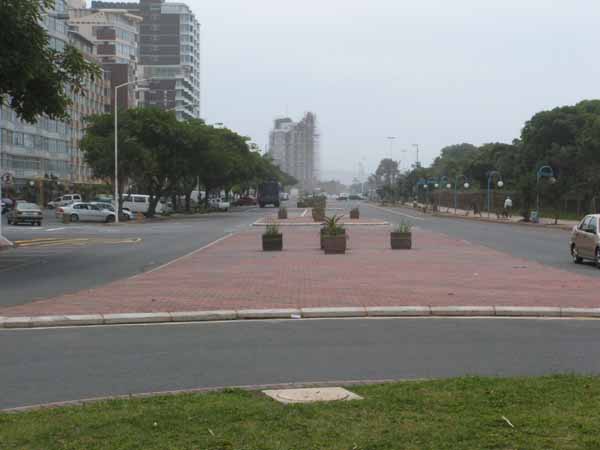
A view from Snell Parade onto Snake Park hairpin, as it is today. Snake Park is on the right-hand side.
Barriers were put up to completely close off the Snell Parade from the Cumberland Hotel and Country Club ends. Walter Gilbert Road was closed at the railway bridge and so too Argyle Road at the Snell Parade end. One lap of this circuit would cover a distance of 2.8 mile in an anti-clockwise direction. The race was held over 40 laps and a total distance of 112 miles.
The organizers received a total number of 28 entrants from all over South Africa of which 26 eventually showed up for the race. They were the following:
Entrants
| Race No. |
Driver |
Car |
H'cap lap time |
Handicap |
| 1 | Dennis Cockerell | Austin Seven | 3:14 | go |
| 2 | Chris Culverwell | Austin Seven | 3:14 | go |
| 3 | Bob Henderson | Austin Seven | 3:08 | 1:36 |
| 4 | Doug Bruin | Austin Seven | 3:06 | 2:56 |
| 5 | Grierson Beall | Austin Seven | 3:03 | 4:56 |
| 6 | Les Kirk | Austin Seven | 3:015 | 5:56 |
| 7 | Bill Massyn | Ford Special | 2:54 | 10:56 |
| 8 | C.H. Brooks | Ford Special | 2:54 | 10:56 |
| 9 | Roy Hatton | Humdat Special | 2:54 | 10:56 |
| 10 | Charlie Clark | Singer | 2:51 | 12:56 |
| 11 | Cyril Shanley | Singer | 2:51 | 12:56 |
| 12 | John Thompson | Singer | 2:51 | 12:56 |
| 13 | Clive Mitchell | BSA Special | 2:475 | 15:16 |
| 14 | M.E. Meek | Ford | 2:475 | 15:16 |
| 15 | Sam Tingle | MG Special | 2:43 | 18:16 |
| 16 | Gordon Henderson* | Fiat Special | 2:35 | 23:36 |
| 17 | Basil Beall* | Riley | 2:35 | 23:36 |
| 18 | Dick Lee | Talbot | 2:34 | 24:16 |
| 19 | Les Miller | MG Special | 2:33 | 24:56 |
| 20 | Orlando Fregona | MG R-type | 2:32 | 25:36 |
| 21 | C. Henry | Bugford | 2:28 | 28:16 |
| 22 | C.W. Moodie | Ford V8 Special | 2:28 | 28:16 |
| 23 | Max Miller | Ford V8 Special | 2:28 | 28:16 |
| 24 | Ray Millbank | Alfa Romeo | 2:28 | 28:16 |
| 25 | J. Ramsay | Jaguar 100 | 2:24 | 30:56 |
| 26 | Eddie Hall | Bentley | 2:16 | 39:16 |
| 27 | Pierre Kelfkens | Bugatti | 2:11 | 39:36 |
| 28 | Basil Beall | ERA R3A | 2:10 | 40:16 |
* did not arrive
Car scrutineering took place at the entrance by the Old Fort Sports Grounds in Ordnance Road between the hours of 16h30 and 18h30 on Friday 23rd January. It attracted a large crowd of on-lookers despite drizzling rain. About 10 of the entered cars failed to show, but were examined on the morning of the race. It was mostly the Johannesburg drivers that had some difficulty in reaching Durban on time. Pierre Kelfkens, one of the pre-race favourites, was delayed when the car that was towing his Bugatti broke down at Mooi River, while on the way to the race meeting. Gordon Henderson also failed to make it when he could not finish his Fiat 9 on time, despite a desperate effort to do so, while Basil Beall withdrew his Riley after he opted to use his ex-Roy Hesketh ERA R3A for the race. It is interesting to note that Beall had to pay the Natal Motor Cycle and Car Club an amount of £2 10s for each of the cars he entered for this race. After the cars were examined it was the turn of the drivers to attend a medical examination that was held at 19h30 at the Federal Hotel that same evening and this was immediately followed by a drivers briefing.
With all the pre-race formalities completed, the stage was set for a most exciting event and already a handful of drivers were considered as favorites for victory. British driver Eddie Hall, who added an international flavour to the race, in a Rolls-Bentley and Beall’s ERA were the firm favorites, but it was expected that local-boy Les Miller in his supercharged MG Midget and also Max Miller in a Plymouth-Ford would be serious challengers. Some experts suggested that Kelfkens’s Bugatti or Lee’s Talbot would walk away with the laurels.
With a handicap time system in place, though, it was anyone’s guess which driver would be the eventual winner, since the handicap was allocated in such a manner to give all competitors a fair chance of victory. Drivers competed under handicaps allocated on the specifications of their cars, their own previous race experience and other relevant factors. Cars would leave the start according to handicap, the scratch man chasing the field. Thus the spectator could take the first car past the post as the winner without subsequent calculations and handicap.
The slowest car would start at “go” or 0:00 minutes, followed by the other competitors as their handicap start time came up, until at last the scratch man got away, in some instances, several laps after the first car started. Theoretically, if the handicappers were very good, the cars would all finish the race simultaneously.
The Race
After the drizzling rain on Friday evening conditions were even worse on race day when spectators and competitors were confronted with almost incessant rain and wind. Despite the miserable conditions great crowds had gathered at the circuit finding some shelter and protection from their raincoats and umbrellas.
The roads that were in use during the race were closed off at 12h30. Shortly after 13h00 the 25 cars and their drivers were lining up at the start-finish line, situated between Argyle Road and the Snake Park Hairpin, in anticipation of being set off by the Mayor of Durban, Councilor Leo Boyd. Pierre Kelfkens was the one competitor that was not amongst the starters after he blew his car’s engine prior to the start. At 13h15 the Mayor fired a pistol to set off the two limit men, Dennis Cockerell and Chris Culverwell, both competing in Austin Sevens. One after the other each of the drivers got their marching orders until the final driver Basil Beall left the start 40 minutes and 16 seconds after the first two competitors. Dennis Cockerell rapidly moved into the lead with very consistent lap times. He had covered nearly a third of his race distance by the time that Beall was set off.
The course was extremely slippery in some parts, but notably at the bend between Sunkist and the Country Club. Drivers were tested to the limit with cars spinning, skating backwards or slithering into the kerbs. Fortunately no serious accidents occurred and nobody was hurt. Bob Henderson got the fright of his life, though, when his little Austin Seven slid backwards into a kerb. The car somersaulted and landed on top of the driver, and then jumped back on its wheels, badly battered. Henderson escaped suffering from shock.
Basil Beall and Eddie Hall were going really well and within 8 laps Beall had wiped out the Bentley driver’s one-minute start on him. With less rain falling in the latter part of the race, their lap times dropped and Beall eventually also clocked the fastest lap of the race in 2 minutes 21 seconds, averaging nearly 72 mph. Hall could lap no faster than 70 mph.
Several other points of excitement stood out amongst the rest of the field. Clive Mitchell was lapping fast in his ear-splitting BSA cyclecar, but had to change wheels frequently due to contact with the kerbs. Les Miller was also tearing his way through the field before he ran into clutch trouble. The supercharger in his MG Midget eventually broke and this meant the end of his challenge. Pure determination kept him going and he eventually was classified fifth at the chequered flag. The Rand drivers had a bad day, for Tingle’s Midget MG had incessant ignition trouble and Lee’s beautiful supercharged Talbot developed carburetor problems.
Cockerell was set for a win when he was leading Beall by nearly five laps, but he eventually came to grief when he had to make a lengthy pit stop after hitting a kerb. This would cost him victory in the end. His mishap and pit stop meant that Beall gained three laps on him. He was now only leading by one lap and the flying ERA had no trouble to overtake the little Austin in the remaining five laps of the race. A bout of misfiring from the ERA, which set in two laps from the end, brought some excitement to the crowd. This didn’t slow Beall very much, in spite of another heavy downpour of rain right at the end, and he received the chequered flag much to the delight of the water-drenched crowd. After Eddie Hall made it to the finish, the surviving competitors were flagged off due to the heavy rain.
The wet conditions were a major contributing factor in the fact that only six cars could finish the race. The final result was as follows:
Result*
| 1 (1) | Basil Beall | ERA R3A | 1 h 39 min 50 sec | 67,3 mph |
| 2 (4) | Dennis Cockerell | Austin Special | 2 h 23 min 19 sec | 46,9 mph |
| 3 (2) | Eddie Hall | Bentley | 1 h 51 min 52 sec | 60,1 mph |
| 4 (3) | Ray Millbank | Alfa Romeo | completed 36 laps | |
| 5 (6) | Les Miller | MG R-type | completed 32 laps | |
| 6 (5) | Max Miller | Ford V8 Special | completed 32 laps | |
| dnf | Dick Lee | Talbot Special | lap 2 |
| dnf | Charlie Clark | Singer | lap 3 |
| dnf | Sam Tingle | MG Special | lap 6 |
| dnf | Bill Massyn | Ford Special | lap 7 |
| dnf | J. Ramsay | Jaguar 100 | lap 8 |
| dnf | Grierson Beall | Austin Special | lap 12 |
| dnf | Chris Culverwell | Austin Special | lap 13 |
| dnf | Cyril Shanley | Singer | lap 13 |
| dnf | Bob Henderson | Austin Special | lap 13 |
| dnf | Orlando Fregona | MG R-type | lap 14 |
| dnf | Roy Hatton | Humdat | lap 15 |
| dnf | M.E. Meek | Ford Special | lap 15 |
| dnf | Clive Mitchell | BSA Special | lap 17 |
| dnf | Les Kirk | Austin Special | lap 18 |
| dnf | John Thompson | Singer | lap 21 |
| dnf | C.H. Brooks | Ford Special | lap 22 |
| dnf | C.W. Moodie | Ford V8 Special | lap 23 |
| dnf | C. Henry | Bugford | lap 28 |
| dnf | Doug Bruin | Austin Special |
* handicap position (scratch position in brackets)
Fastest lap: Basil Beall (ERA) in 2 min 21 sec (71,5 mph)
The prize-giving ceremony took place at the R.D.L.I. Hall in the city where Basil Beall was presented with the Roy Hesketh trophy and a cash prize of £100. Mr. R. Johnston, Chief Constable of Durban, presented the prizes to the winning driver and said that he had been impressed by the way the race was run and that he would in future support applications for similar events. He stressed, though, the need for a car track in the Durban area. The Snell Parade circuit was used annually as a racing venue until 5 September 1955 when it was used for the last time. Racing in Natal eventually found a permanent home at the purposely-built Roy Hesketh circuit in Pietermaritzburg.
Following this very successful race meeting on Durban’s Snell Parade, Pietermaritzburg, Johannesburg and Cape Town followed suit, so that four major races were eventually held in 1948. These post-WW2 pioneers set the foundation in establishing motorsport as one of the most popular sporting codes in South Africa.
Footnote
Apart from the Fairfield Handicap races in Durban, the city also played host to motor races in 1938 and also 1988.
The Durban Motor Cycle Grand Prix was a popular annual event during the 1930s that was organized by the Parkhill Motor Cycle and Light Car Club. For the meeting on 1 August 1938, on the Bluff Marine Drive circuit, the organizers decided to include a motor car race on the programme. It was called the Parkhill 75.
On 25-27 March 1988 a very successful sportscar race was also held on the city’s streets in the vicinity of the Kingsmead sport stadium. The main attractions of this meeting were world famous drivers like David Piper and Richard Attwood.
